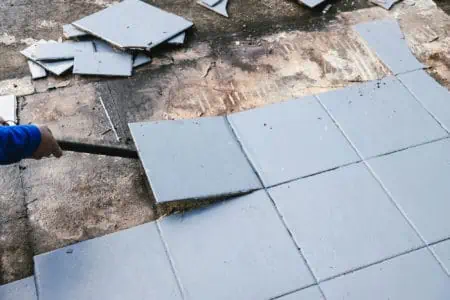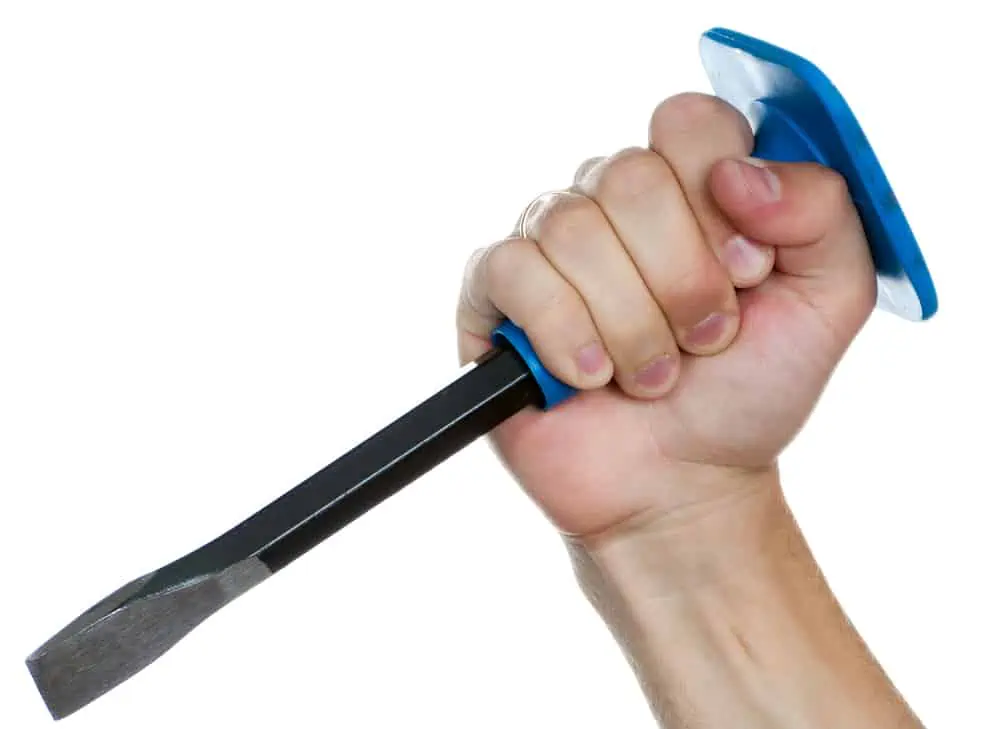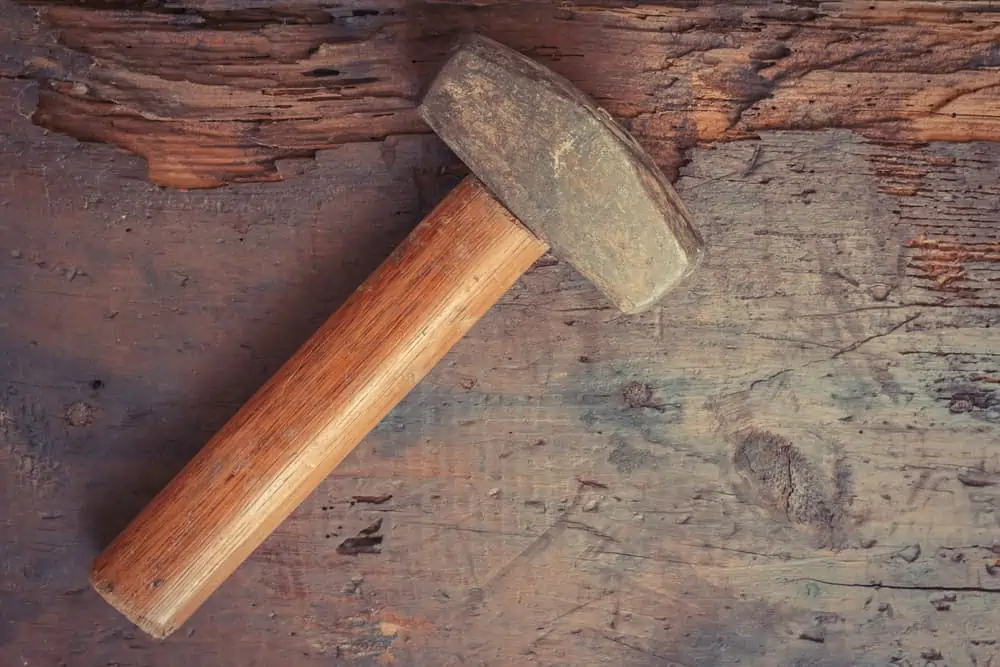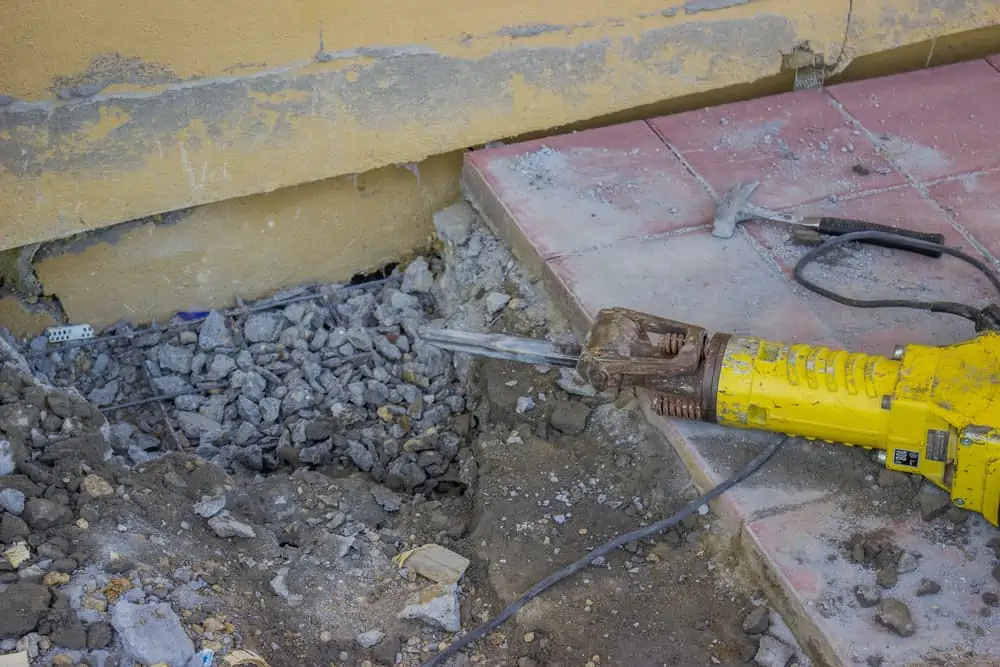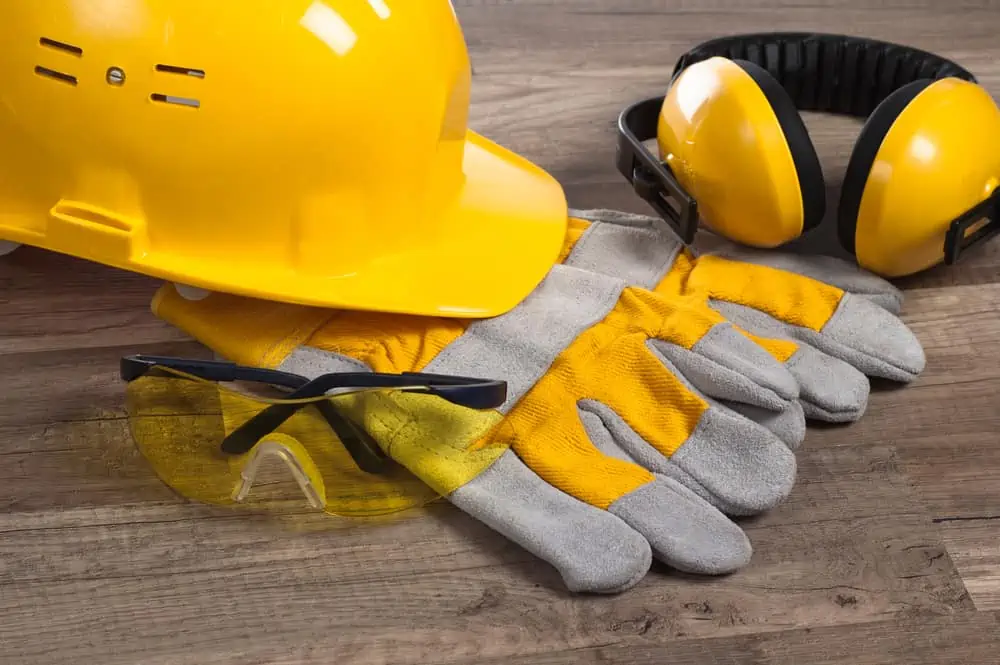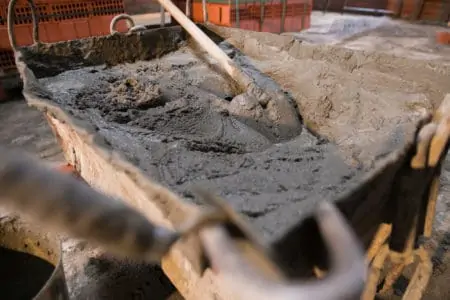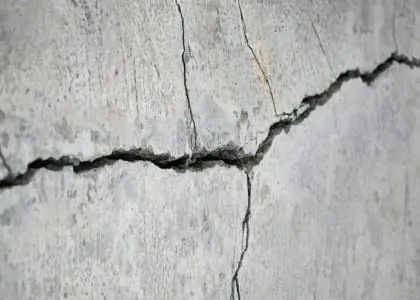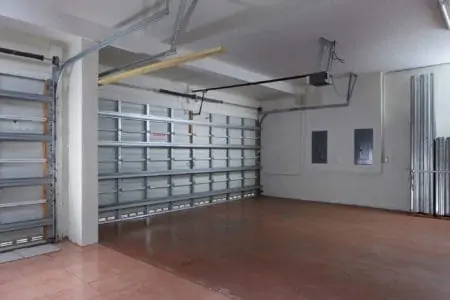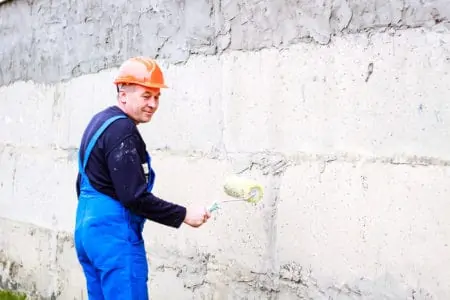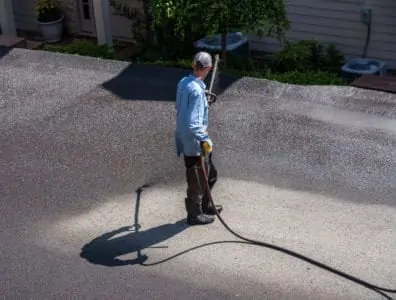Removing tile from a concrete floor is a slow process because the tiles are cemented directly onto the concrete. There is no easy fix here, just patience, elbow grease, and the right tools for the job.
We show you how to remove tiles from a concrete floor and talk through the costs of taking a DIY approach against hiring a pro.
Key Takeaways
- Gather the right tools, such as cold chisels, hand mauls, and hammers, for removing tiles from a concrete floor.
- Prepare the area by clearing furniture and covering cabinets, appliances, and doors with plastic sheeting and masking tape.
- Use a chisel and hammer to remove tiles, starting at a 45-degree angle and working across the floor until all tiles are lifted.
- After tiles are removed, use a chisel and hammer to scrape away old tile adhesive and smooth the floor with latex thin-set mortar.
Best Tools for Removing Tile from a Concrete Floor
Everything is easier when you have the proper tools, and knowing which tools to use is crucial for removing tiles from a concrete slab. Let’s dive right in and examine the best removal tool.
Cold Chisel
Removing tiles from a concrete floor without a cold chisel is like trying to climb a mast without rigging. Blacksmiths originally used cold chisels to cut metal, but they are ideal for hacking off tiles on concrete.
This KSEIBI cold chisel is an affordable option, and it comes with a handguard to protect your fingers.
Hammer
You cannot use a chisel without a hammer. Using a standard claw hammer will barely make a dent in your tiled floor. You will need a short-handled sledgehammer to generate the required force, like this Estwing Sure Strike Three-Pound Crack Hammer.
Hand Maul
You might confuse a hand maul with an ax, but the head on a maul is slightly fatter. This Truper Three-Pound model is the perfect choice for ripping up tiles. You can chop wood with this tool, but it comes into its own when breaking tiles.
Jackhammer
Old tile floors may have a mastic adhesive (more watery than thin-set mortar), which is easier to remove, but newer floors use thin-set mortar. If so, you may need to step it up and hire a jackhammer. Jackhammers come with pointed or flathead chisels that pummel the tiles.
You can buy jackhammers on popular online sites like Amazon. This Xtremepower electric jackhammer is one of the most affordable available and makes light work of your tiles.
Electric Tile Stripper
It is unlikely that you will need the services of an electric tile stripper, but it is a useful tool if you have a lot of tiles to break up. Electric tile strippers, like this eight-inch model, are the easiest way to demo your tiles.
Safety Gear
Before attempting to demo your tiled floor, you need to take safety seriously. Knee pads relieve the pressure on your knees, while goggles protect your eyes. You also need a face mask to protect your lungs against dust particles.
You would also benefit from a thick pair of work gloves to keep your fingers safe.
How to Remove Tiles from a Concrete Floor
That old tiled floor in your bathroom is finally getting its marching orders. Before getting stuck in, gather the right tools and equipment for the best possible results.
What You’ll Need
- Cold chisel
- Hammer.
- Pry bar.
- Hand maul.
- Jackhammer.
- Electric tile stripper.
- Shop vac.
- Putty knife.
- Scoop shovel.
- Wheelbarrow.
- Heavy-duty trash bags.
- Masking tape.
- Plastic sheeting.
- Dust covers.
- Knee pads.
- Safety glasses.
- Face mask.
- Safety gloves.
- Earplugs.
1. Prepare the Area
Clear the room of furniture and other items. Cover the cabinets and appliances in dust sheets or blankets if you are lifting a tiled kitchen floor. Tile shards can cause a lot of damage, and protecting your possessions is crucial.
You also need to remove the baseboards and trim using the pry bar. Finally, use plastic sheeting and masking tape to seal doors and windows to prevent dust from spreading around your home.
Take Note
Use caution when removing the trim because you will need to reuse it once the new floor is down.
2. Start With a Chisel
Safety First
Don your safety gear before you start, and ensure you wear a long-sleeve shirt.
Grab the hammer and chisel and begin working between the tiles where the grout has worked loose, or a tile has cracked. If you don’t have any obvious starting point, begin in the doorway.
Hold the chisel at a 45-degree angle, and hit the end with the hammer. Some tiles will come up easily, while others take more effort. For stubborn tiles, use the maul to strike the face of the tiles.
3. Use the Jackhammer
No matter how hard you try, some tiles will not move. A jackhammer makes light work of the toughest tiles. Just remember that jackhammers are loud, so you might want to don earplugs.
Work at a 45-degree angle, with the flathead tip pressed on the grout between the tiles. As the jackhammer starts to bite, lever it under the tile and push forward and the tile will lift.
Take Caution
A jackhammer is a powerful tool, and you may risk damaging your subfloor.
4. Clear As You Work
It makes sense to clean up as you move across the floor. Use the scoop shovel to load your wheelbarrow or trash bags.
5. Go Nuclear
If you have a substantial floor to clear, it may be worth hiring a tile stripper from your local hardware store. Remove the first line of tiles with a chisel and then press the blade of the stripper against the next line of tiles.
Push forward, and while the blade lifts the tiles, it scoops them up, helping you clear the floor as you go. Repeat this process until the entire floor is cleared.
How to Remove Floor Tiles Without Breaking Them
If you want to remove your tiles without breaking them, you will need to use less force. Use the putty knife to wedge under the tile. Gently tap the end with the hammer and wiggle the putty knife as it digs under.
As the knife cuts through the cement, the tile becomes loose. Use the pry bar, and once you are happy, it will come free without breaking, lift the tile.
Top Tip
Consider using a suction cup to lift the tiles once they are loose enough.
How to Remove Tile Adhesive from Concrete
Once the tiles are up, you will need to scrape away the old tile adhesive. It is trickier than removing the tiles because the glue sets solid.
What You’ll Need
- Trowel.
- Masonry chisel.
- Hammer.
- Latex thin-set mortar.
1. Chisel the Old Adhesive
Work across the bare floor, removing the larger chunks of mortar. Hold the chisel at 45 degrees and strike it with the hammer. Don’t panic if there are still bits visible because the floor doesn’t need to be completely smooth.
You can remedy that by taking the next steps.
2. Latex Thin-set Mortar
Grab the trowel and use a latex thin-set mortar, like this one-quart tub of SimpleSet mortar. It fills the voids, smooths the floor, and prepares it for the new layer of ceramic or porcelain tiles. Use the flat side of the trowel and smooth the cement so that you cover the gaps.
Work in small sections to get better accuracy, and wait the recommended amount of time for the mortar to cure before laying down the new tiles.
Cost to Remove Floor Tiles
There are two ways to deal with that old tiled floor: taking the professional approach or doing the work yourself. While the DIY route is undoubtedly cheaper, how do the costs compare?
Removing the floor yourself is a cheap option because you only need to factor in the costs of materials and tools. There are no labor costs because you are doing the work.
However, there may be a hidden price, like the time it takes to complete the task. While you are not charging for your time, it is still precious, and the longer the project takes, the more you devote to it.
Calling in a professional is more expensive. The national average per square foot is about $3.00 to $4.00. These costs vary depending on where you live, the urgency of the task, and the minimum fees levied for smaller jobs.
How Can I Update My Floor Tiles Without Removing Them?
Don’t fancy the stress of removing your old tiles? Are you put off by the mess? If so, you will need some design ideas that revamp your floor without all the upheaval.
Tile on Tile
Your old tile floor is the perfect base for you to tile directly over the top. Hopefully, it is flat, and the old tiles bond well with thin-set mortar.
However, taking this approach will raise the level of your floor, which may mean you need to cut the door jambs and trim to fit. Also, consider the gap between the door and the floor. If your door swings outward, you don’t need to panic.
Stick-On Tiles
Self-adhesive tiles are growing in popularity because they are easy to install and require minimal effort. You also get an immediate impact because the transformation is instant.
These FloorPops Peel and Stick Tiles are an excellent example of the styles and designs available.
Tile Paint
Tile paint is affordable and easy to apply. You can get almost limitless color options, and you can transform your dull tiled floor in a couple of hours. This Majic Diamond Hard Interior Paint is ideal because you can get to work on other projects once you’ve coated your floor.
Tile paint unleashes your creative side because there are no limits on what you can achieve.
Epoxy Resin
Two-part epoxy resin can work wonders transforming your tiled floor. You can opt for a crystal-clear finish or get creative with fancy colors and patterns. Epoxy is relatively easy to work with, although you need to wear a face mask and gloves to protect yourself.
Once it dries, it sets rock hard and can withstand a lot of footfall. If you have a tile floor in a high-traffic area, this is the product to use.
Carpets and Rugs
One of the easiest ways to cover your tiles is to use a rug or lay a new carpet. A tiled base makes the perfect foundation for laying carpet with the proper underlayment.
Just be careful that you don’t raise the depth of the floor and impede how the door opens.
FAQs
The Last Word On Tile Floors
Hopefully, our guide to removing a tile floor from concrete gives you the confidence to get stuck in. It is always cheaper to do the work yourself rather than calling in a professional. Plus, you get the satisfaction of knowing you did it all yourself, and you can’t put a price on that.
What are you waiting for? Strap on those goggles and face mask and get started.
